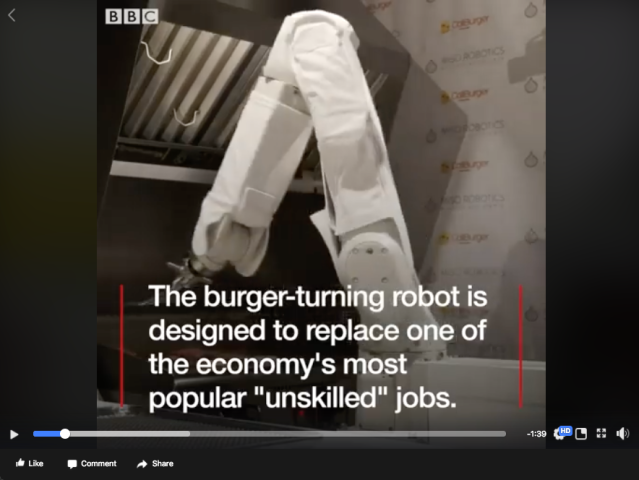Meet Flippy: the burger-turning robot designed to take a job away from expensive, healthcare-dependent, unionizing-inclined, burger-flipping humans!

Oh boy, said the California-based burger chain CaliBurger: #FlippyIsHere!
…and then, within the span of a day, presto blinko automatic-fire-o! #FlippyWasCanned.
It wasn’t that Flippy was bad at flipping. The spatula-wielding robot, which relies on image-recognition and heat-sensing technology, can flip up to 2,000 burgers a day. It’s just that it was too fast, and its human co-workers were too slow.
As of last week, the chain had plans to install Flippy units in 50 locations. The Flippy units, sold by Miso Robotics and specifically designed for CaliBurger restaurants, cost around $60,000 each and another $12,000 a year to run. The plan is for them to appear exclusively in CaliBurger restaurants for the next six months. The company is hoping that the rest of the 50 locations, including Seattle and Annapolis, Maryland, will be Flippified by year’s end. However, all has not started as expected.
The first Flippy debuted in Pasadena, California. It did great. But when USA Today stopped by last Thursday, a day after it was plugged in, the robotic arm was still on display, but it was unplugged. The kitchen was being run entirely by human staff.
It wasn’t Flippy’s fault that she got sacked. It was those slow-mo human co-workers who gummed it all up. The problems: First off, the restaurant was swamped with visitors, both those interested in chewing on a machine-made sandwich and those interested in buying a robot.
But even more germane was the problem of those slow, slow humans. Anthony Lomelino, head of technology at CaliBurger, told USA Today that Flippy has to rely on humans to work the cash register, prepare the patties for the grill, season them, lay on the cheese slices, put on lettuce and other burger embellishments, to package a burger up, hand it over to a diner, and open and close the outlets.
Looks like they’re going to have to work out the choreography, Lomelino said, and make sure they don’t get flapjacked by those swinging spatulas:
Mostly it’s the timing. When you’re in the back, working with people, you talk to each other. With Flippy, you kind of need to work around his schedule. Choreographing the movements of what you do, when and how you do it.
John Miller, CEO of Cali Group – which runs the CaliBurger chain – has told the BBC that Flippy and its robotic brethren/sistren means that the future of burger joints has fewer humans in it. (Obviously.)
That might not be so bad, Miller said: after all, burger flipping is “not a very fun job, right?” CaliBurger spends time and money training workers who then up and take off after a few weeks, he said.
Robot makers say that they’re just getting started with what robots can do. They also predict that new jobs will replace the ones that robots take away. But as the BBC points out, no one seems to know what those new jobs will be.
Perhaps Flippy has a few ideas on that. Training humans how to work with robots might be a start, for one thing. At this rate, though, they do know how to do at least one thing to maximize efficiency: humans know how to pull out a plug.
Image courtesy of Miso Robotics / YouTube

delayedthoughtengineering
I wonder about Flippy’s operational lifespan. Assuming that the $12k per year cost includes cleaning and maintenance, I would expect such an industrial robot to last perhaps 10 years. (Might be shorter, depending on grease splashes.) If it lasts 10 years, that amortizes out to less than $18k per year, including the $12k running cost. On the other hand, to keep a $8/hr cook cooking 16 hours a day (2 shifts?) for about 360 days per year, even at minimum wage, that’s a whopping $46k a year. Follow the money, and you’ll see that robots are becoming the financially obvious solution to keeping costs down.
Flippy was taken offline after a day, but that is because the humans around Flippy could not adequately adapt to Flippy’s speed.
I’d feel more comfortable about this if there were live experiments about the feasibility of Universal Basic Income, or No Cost Commodities. If an average person cannot find a job to earn income, but they still require an income to pay bills and buy food, a lot of people are going to end up relying on the largess of others, and there’s simply not enough grace to go around.
Eric
Robots are not helping but only killing the people’s livelihood. When machines took over human jobs in last 100 years, at least the people are able to find other jobs. But when robots take over low class as well as high class jobs, what jobs can the people do then? I predict in next 25 to 50 years, there will be lots of poverty and unemployment.
Art
She?
Tracy
Of course Art. Flippy has to be female. All the male robots are working on the Auto Manufacturer assembly lines. Oh dear! I have already annoyed the Crypto Currency Fanboys and now the Feminist. Will I never learn to be politically correct? :)
Bender Bending Rodríguez
That’s Fembot baby
Tracy
Here is why these robots will never be successful in a fast food restaurant. These places are to unpredictable. You have quiet times and rush times but they are always in flux. Robots are good at repetitive tasks but what happens when things slow down. Are you going to shut the robot down? While the robot is idle a human can do other tasks until called to, in this case, flip burgers. I don’t think we need worry. Besides, these machines need at least two humans to keep it working. Just ask the auto industry. :)
Keith
They just need to trot out Preppy, Fryey, and DrinkPoury… also Baggy.
MrGutts
Maybe they can put Flippy on the front counter area to slap the hell out of people who are on there cell phones holding up the lines.
Bryan
DUDE.
Then that puts Slappy out on the streets! Have you no sympathy for those losing their jobs to robots?!?!
Eric
In next generation, lawyers, architects, engineers, school teachers, down to lowest class jobs like servants, building laborers, road sweepers, will all be taken over by robots. So, what do those people do? Well, don’t worry, it’s been predicted by scientists that by year 2135, a rock from outer space will destroy the earth.
Anonymous
It sounds as though this robot wasn’t “too good” but simply didn’t fit into the workflow of the business.
With no intelligence or intuition, it sounds as though the robot was no good at all, given that everyone else had to reorganise less efficiently around its inflexibility.
Sounds like a case of a hammer looking for a nail to me – the product was not as cheap or effective as the sales guy from the robot company said.
s31064
“But even more germane was the problem of those slow, slow humans. Anthony Lomelino, head of technology at CaliBurger, told USA Today that Flippy has to rely on humans to work the cash register, prepare the patties for the grill, season them, lay on the cheese slices, put on lettuce and other burger embellishments, to package a burger up, hand it over to a diner, and open and close the outlets.”
As Keith said above, “They just need to trot out Preppy, Fryey, and DrinkPoury… also Baggy.”
In reality, all they need to do is make it variable-speed and the store manager can set it to the speed (most of the burger joints I’ve been to it would more rightly be called hindrance) of the human workers.